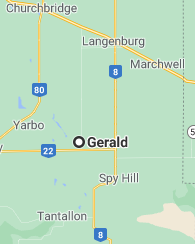
The map shows Langenburg and the railway tracks to Churchbridge. Gerald is several miles south of Langenburg where the village Vallar was established. Further south is the village Tantallon east of which was Hólar.
During the last decade of the 19th century, there was a significant shortage of available free land in the most significant Icelandic settlements in Manitoba, Minnesota, and North Dakota. Children who accompanied their parents in the early years of the emigration period from Iceland and others born in the west grew up in such communities. They were now keen on starting their own farms on their own land and, with no land available, they needed to look elsewhere. Each year, emigration from Iceland saw people leave for America, most of whom had some farm experience, so these immigrants likewise were looking for available land. The Northwest Territories in the period in question were the obvious choice. Since 1887 Icelanders had travelled west from Winnipeg to explore and settle in this part of the Canadian prairie so, for most, regions just west of the Manitoba boundary was logical decision. The increasing availability of the railway west obviously helped; men boarded the train in Winnipeg and travelled as far west as the train went. Thus at this time, Langenburg was the destination and from there settlers headed north, west, or south.
Icelandic Settlement: Two neighbors in Manitoba, Guðjón Jónsson from Vopnafjörður and Kristján Pálsson from Fáskrúðsfjörður, had lived in Argyle Settlement for some time and both were faced with a shortage of available land there, forcing them to consider a move. Guðjón had emigrated from Hámundarstaðir in 1889 with his wife, Guðríður Sigurðardóttir and fours sons, Sveinn, Sigurður, Jón Björgvin, and Hannes (died after a few years in Manitoba), all under ten years of age. Eleven years later it was obvious that the three remaining sons wanted to farm. Likewise, Kristján, at the age of ten, had emigrated in 1876 with his parents, Páll Jónsson and Ólöf Daníelsdóttir, and lived with them in the Gimli area for four years and in Winnipeg for quite a few. After a year or so near northern Lake Manitoba, they eventually settled in Argyle. Soon it became obvious to Kristján and his brothers, Marteinn, Albert, and Björn, that there was no available land in the Argyle Settlement. Guðjón and Kristján went ahead in 1900; they had heard of Icelanders settling in the Qu’Apelle Valley. The train from Winnipeg brought them to Langenburg and from there they headed south. When they had less than 10 km (6.2 miles) to Tantallon (see map), they paused and felt the surrounding area was worth a closer look. After careful examination, they concluded this was good land and both homesteaded there. This was just south of Gerald and marked the beginning of a new Icelandic settlement on the Canadian Prairie which the named the Vallar Settlement (Vallarbyggð). Páll, Kristján´s father, homesteaded there as did his three brothers. Sveinn, son of Guðjón, likewise claimed land. During the following years, quite a few Icelanders drifted in and by 1910 it had become a well populated settlement.
Social life: From the beginning, Kristján Pálsson showed interest in community affairs and when a committee was established to manage official affairs, he was on the board of directors. In 1910 when the Rural Municipality of Gerald was established, he was appointed head of the council. Although settlers of a different ethnical background had moved to the settlement, Icelandic ways dictated most of the social life. A reading club was based on the system used in other Icelandic communities both in Canada and the United States. An Icelandic congregation, Ísafold, was established in 1904; two ministers, Rev. Guttormur Guttormsson and Rev. Hjörtur Leó, who served the congregation in Churchbridge visited Vallarbyggð regularly to conduct services. A Good Templars Society was established by Sigurður J. Jóhannesson and Björn Sigvaldason which organized various Icelandic events. In 1912 settlers began to move northwest to a new Icelandic settlement south of the Quill Lakes later to be called Vatnabyggð, or Lakes Settlements.
English version by Thor group.
